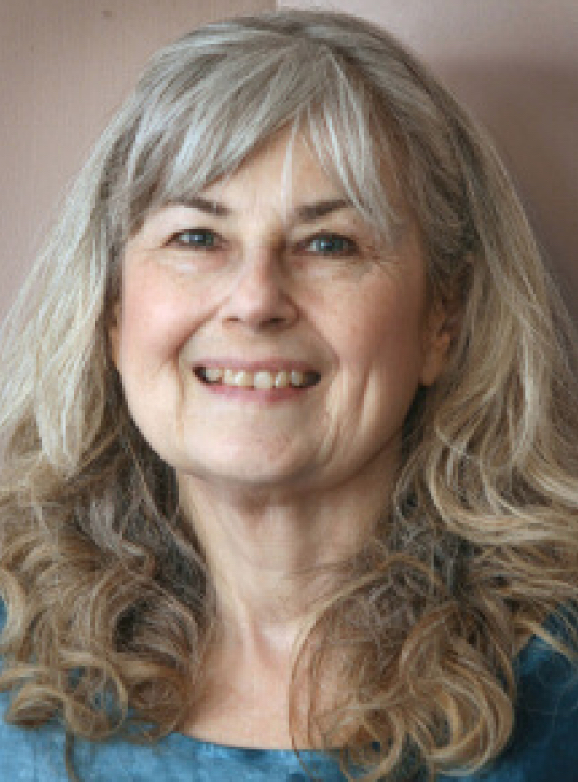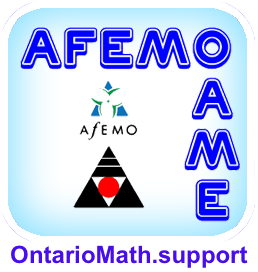President's Message - June 2017
The OMO Factor

JUDY MENDAGLIO
judy.mendaglio@oame.on.ca
I have been thinking about some of what I heard as I walked around as students worked with their partners on the wonderful challenges written for them by our CHAMPions. (Yes, assessment for learning through observation and conversation-and on a Saturday morning!) Many things I overheard caused me to reflect on how we teach children mathematics. I would like to share some of my thoughts.
Students were given a photo of an actual roped-off swimming area at an Ontario park. They were asked if the park authorities had created the largest possible swimming area with that length of rope. Rather quickly (way too quickly), I heard:
"The largest area is always a square."
"It has to be in a ratio of 2:1 because the shoreline is one side."
What do these two statements have in common? Lots. For one thing, neither gave the correct solution to the problem. For another, these were obviously "rules" that students had learned. I put the word "rules" in quotation marks deliberately. What is a "rule"? Definition of rule: "One of a set of explicit or understood regulations or principles governing conduct within a particular activity or sphere." (Thank you, Google.)
To me, there are two important pieces in this definition: principles governing conduct and within a particular activity or sphere. We all know that there are different principles governing conduct in different spheres. You are usually free to get up from your desk when you are at work, but not when you are writing an exam. You can drive 100 km/h on the highway, but not on a residential street. Students understand that. Moreover, they can probably tell you why that rule makes sense. Why do they not understand that rules in mathematics also have spheres (environments, contexts) in which they apply, and spheres in which they do not? Somehow, students view mathematical rules as absolute- they always work. Since they always work, there is no need to pay attention to the circumstances under which they are applying the rule. I have to think that somewhere, they were misled by an adult in their lives. Maybe it was a parent, maybe a teacher, maybe a tutor or an older sibling. I don't know. But what I do know is that we can alleviate a lot of frustration that students experience when doing mathematics if we are very clear about when a "rule" can be used, and when it can't. I could probably treat all the readers of this President's Message to a nice meal if I had a dollar for each time a student had used a "rule" when that rule was not available to use. "A2 + B2 = C2?" No, that is not the rule. The rule is: In a right triangle,...." This is the sphere in which this rule is valid. "Squaring always makes a number larger." Don't tell that to 1⁄2. A vertical stretch is the same as a horizontal compression. Not if you are studying periodic behaviour. These are all examples of rules that my own students came into my class carrying around with them. Students who had foregone thinking in favour of rule- remembering were at a distinct disadvantage, not only because they got questions wrong, but because they had not learned how to persevere and try different strategies to solve problems that did not easily fit into one of their rules. I am guessing that many students are not even aware that mathematical rules, like life rules, have a sphere. I know that we can help with this. When students begin learning "rules," maybe we can use simple language to describe the sphere: "When we have a right triangle, we can...," "If our shape is a quadrilateral, then...." Even those "rules" that we know don't last very long in a student's academic life, like "You can't take a bigger number away from a smaller number" and "You can't take the square root of a negative number," have spheres that students can understand, if we are thoughtful about how we present them. I am certain, based on many years of asking my students as well as my colleagues, that students rarely understand why a rule makes sense. It's no surprise that students feel as if someone has pulled the rug out from under them and then say something like "Math is stupid" when they are inevitably told that they cannot use that rule in this circumstance.
We saw a few students understand what we mean when we tell them, "Division by zero is undefined." As with the rules working within their spheres, operations have spheres. Divide 4 by 2 works everywhere. However, divide 4 by 3 doesn't work when you only have the counting numbers 1, 2, 3,.... Mathematicians are creative, but they like consistency. The operations were all created by people. They didn't come pre-made. They were defined to have a particular meaning. They are well defined within their sphere. However, no one ever came up with a definition for dividing by zero that didn't upset some other part of the well-defined world of mathematics that was already set up, so everyone agreed to leave that undefined. Division by zero has never been given meaning. It is undefined; rather like the word "kerthancular."
So, what have I been reading? Well, it seems I am a bit behind many of you. I have been reading a lot about number talks, and most recently read Making Number Talks Matter: Developing Mathematical Practices and Deepening Understanding, Grades 4-10. No wonder so many people are reading and talking about number talks. In this particular book, I saw how rich investigations, vibrant conversations, and deep and meaningful learning could come from some well-selected, but basic, computations. While I have long valued the area model for multiplication for the way it provides an organizer to deconstruct and reconstruct numbers and algebraic expressions, I had never thought much about the extraordinary variety of ways that students might bring their own understanding and curiosity to other operations. However, the true joy of this book, for geeky me, is the way the authors build student understanding of the properties of the mathematical operations (commutativity, associativity, distributivity) through these number talks. The talks, and the consolidation that follows them, provide students with a way to understand (and remember) some very abstract mathematical concepts, all while allowing them to become more fluent with numbers and operations. What more could you ask for? Imagine how this exchange with a Grade 12 OMO volunteer would have been different if this student had had the benefit and joy of number talks:
Student (to me): How many students are we expecting today? Me: Nineteen teams, four students a team, so....? Student: I can't do that without a paper and pencil or a calculator.
Previous Message:
Spring Into Something Completely Different
Next Message:
INCOMING PRESIDENT'S MESSAGE | JILL LAZARUS


















 Like us on FaceBook
Like us on FaceBook